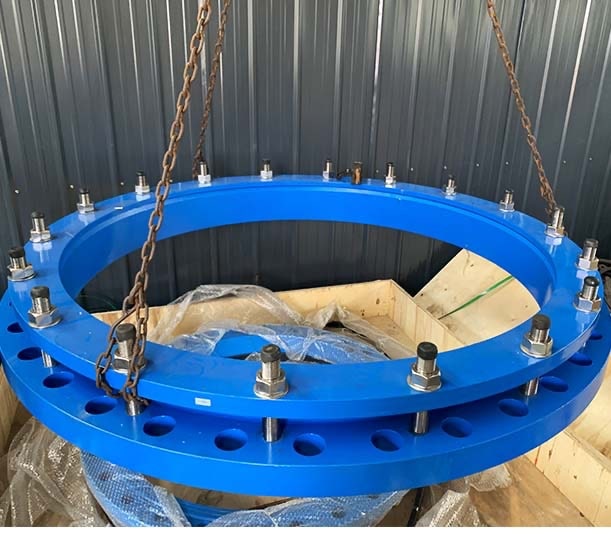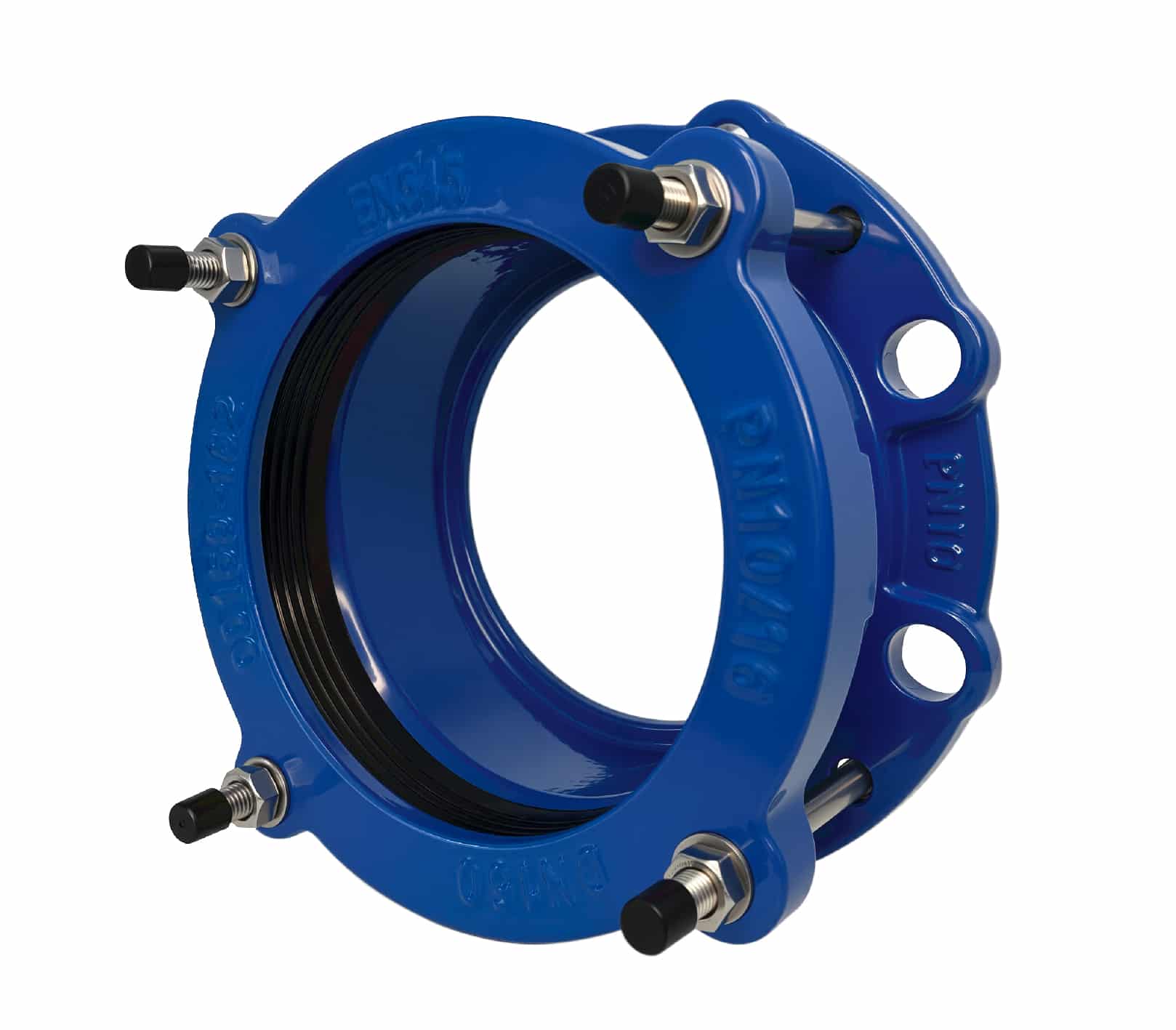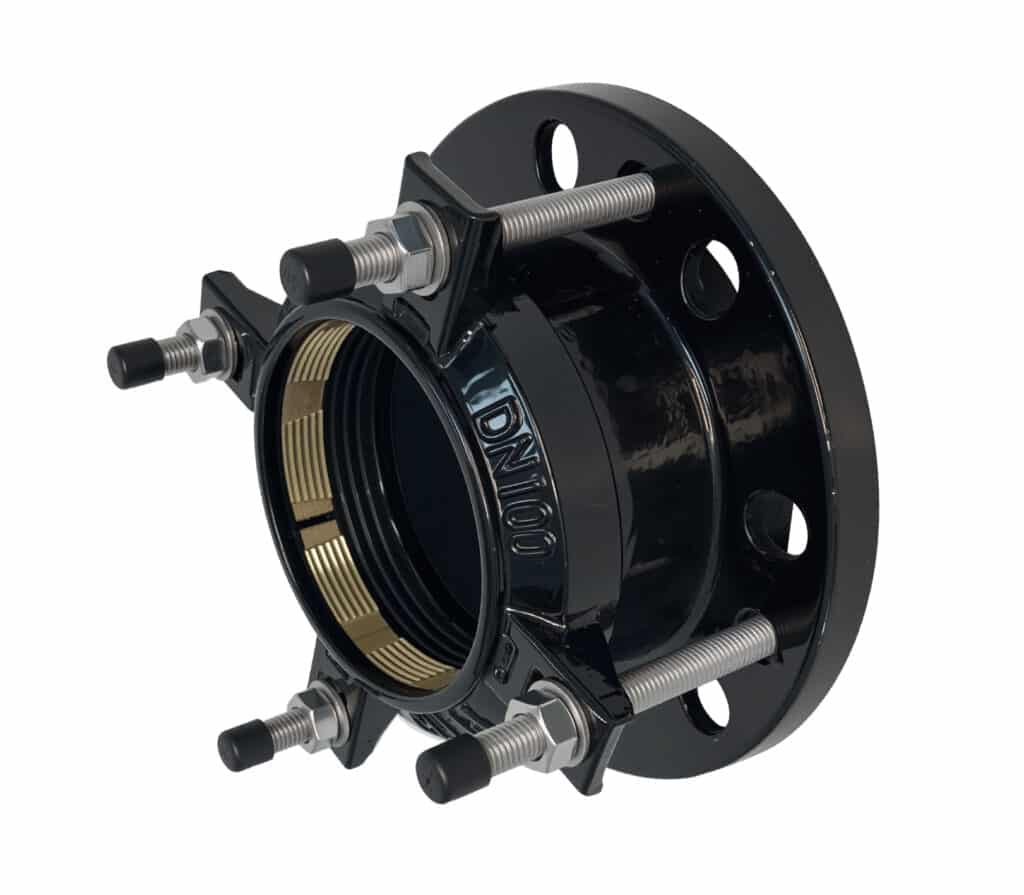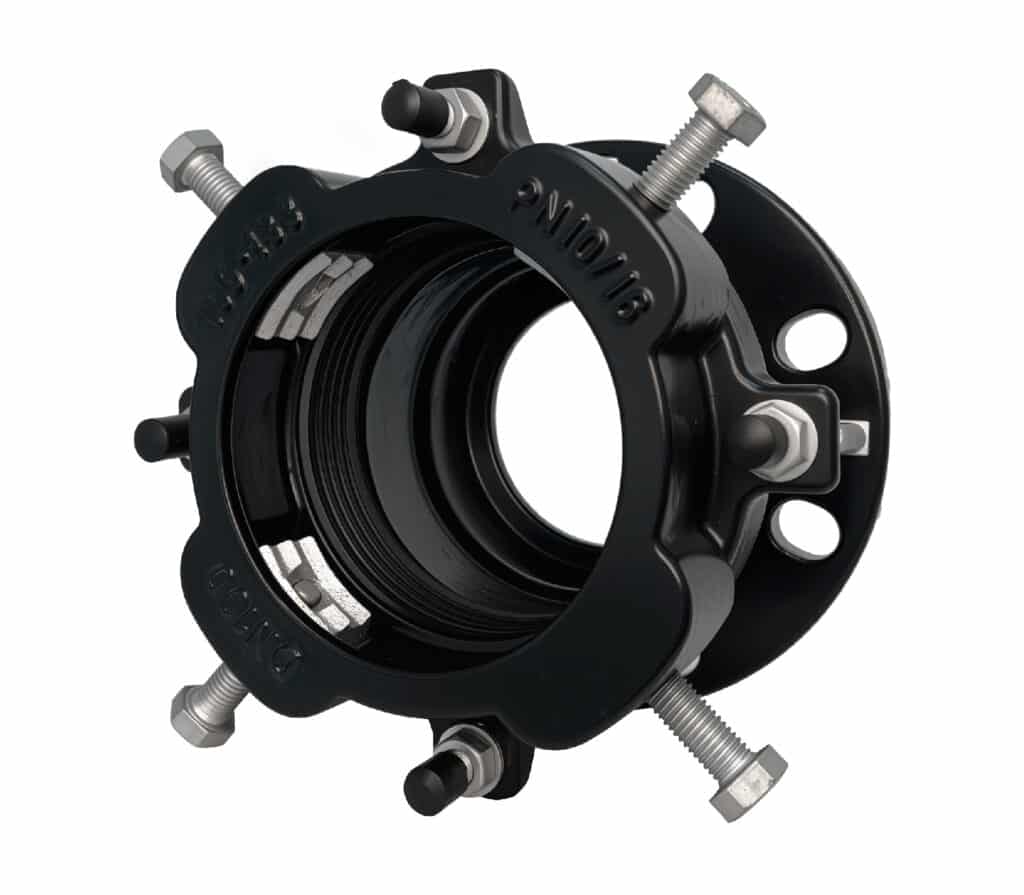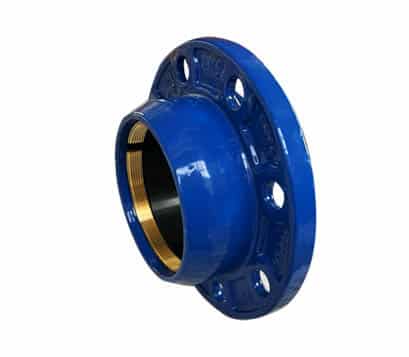Judberd is a Chinese manufacturer that specializes in designing and manufacturing flange adaptors. We have been doing this for 35 years. We make flange adaptors in ductile iron, carbon steel, and stainless steel. We make universal flange adaptors, restrained flange adaptors, MJ flange adaptors, Aquagrip flange adaptors, quick flange adaptors, and more. We also customize flange adaptors to fit your project. Here is an example of a DN3600 (pipe OD 3820) flange adaptor with harness that we customized for a client. We have been doing this for a long time. We know a lot about flange adaptors. We will tell you what a flange adaptor is, how to select the right flange adaptor, how to install a flange adaptor, and how to maintain a flange adaptor. If you have any questions about flange adaptors, please contact us.

Flange Adaptor Basics
A flange adaptor is a special pipe fitting that connects pipes to flanged equipment or valves. It has a flange on one end and a mechanical compression connection on the other. Flange adaptors are used in pipelines to make quick, secure, leak-proof connections between pipes and other flanged pipeline components.
Flange adaptor can be used to Connect Different Pipes, it allows pipes made of different materials or different sizes to connect smoothly to valves, pumps, and other flanged fittings.
meanwhile , it provides adjustability and flexibility, making installation easier and accommodating slight pipe misalignments or minor dimensional variations.
It also makes it easy to install and take apart without needing special equipment, making pipeline maintenance and repair easier.
Compare to pipe coupling,Flange adaptors are specialized fittings used when connecting pipes directly to flanged equipment or valves, while couplings are more general-purpose fittings used to connect pipes directly to each other, especially when you need flexibility and adjustability.
When you are talking about flange adaptors, you need to tell us the flange adaptor size (DN), the pipe material and outside diameter (pipe OD), and the pipeline working pressure (PN value). Unless you tell us differently, the pipeline working pressure is usually the same as the flange PN rating. You also need to tell us the flange design standard. With that information, we can tell you the best flange adaptor for your job.
The Way to Select Right Flange Adaptor
Different applications have different requirements for the material, gasket, surface treatment, and structural design of the flange adaptor.
For Water Supply pipeline, Ductile Iron or Carbon Steel body material flange adaptor is recommended, EPDM gasket (Good for drinking water) which is WRAS, ACS ,NSF etc certified is required, For Surface Treatment, you need to choose FBE epoxy powder coating or non-toxic coatings certified for drinking water.Normally , the pressure is low for water pipeline, so usually PN10, PN16, PN25 is enough for flange adaptor working pressure.
For Irrigation Pipeline, We recommended Ductile Iron, Carbon Steel, or Cast Iron body material for lightweight applications. and EPDM gasket is 1st choice because it is Economical and reliable.For surface treatment, you can choose hot-dip galvanizing, bitumen paint or FBE coating.Compare to water supply ,the surface treatment is much lower in price because no drinking water certificate is required.For Pressure Rating (PN), Usually it is PN10 or PN16.
For Fire Fighting pipeline,We recommend ductile Iron (preferred) or Carbon Steel body material, for Gasket, EPDM (UL/FM certified for firefighting) is your best choice.For Surface Treatment, FBE epoxy powder coating is good, but you need to use red color for fire fight pipeline system.For Pressure Rating (PN), Usually it is PN16 or higher, must have UL/FM certification.
For Oil Pipeline, we recommend Carbon Steel or Stainless Steel (corrosion-resistant) as body material, For gasket, you need to choose NBR (oil-resistant rubber) or Viton material. For Surface Treatment , High-grade anti-corrosion coating, such as polyurethane or high-performance epoxy coatings is recommended. For Pressure Rating (PN), it is based on oil pressure, usually PN25 or higher.
For Gas Pipeline, We recommend Carbon Steel, Stainless Steel, or Ductile Iron depending on transported medium and pressure as flange adaptor body material, Gasket Material should be NBR (gas corrosion resistant), For surface Treatment, you need to choose High-grade corrosion-resistant coating (e.g., epoxy coating), For Pressure Rating (PN), Usually PN16 or higher, complying with gas pipeline safety certifications
For Seawater Pipeline, we recommend Stainless Steel (SS316 or higher) or Ductile Iron with advanced anti-corrosion coating like Ebonite Hard Rubber or EPDM Rubber Lining. you can choose EPDM or specialized seawater-resistant rubber. For Surface Treatment, Higher-level anti-corrosion epoxy is needed.Pressure Rating (PN) is Generally PN16, PN25 or higher based on pipeline design.
For Acidic Liquid pipeline,We recommended Stainless Steel (SS316 or SS316L) or Carbon Steel lined with PTFE for flange adaptor body material, For Gasket Material ,you need to choose Viton or PTFE which have good performance for Corrosion-resistant.For Surface Treatment, Internal anti-corrosion lining (e.g., Teflon/PTFE) is needed.For Pressure Rating (PN), it is based on corrosiveness and temperature of media, usually PN16 or higher
For alkaline Liquid pipeline, We recommend Stainless Steel (SS304, SS316), Carbon Steel with internal lining for flange adaptor body material. For Gasket , you need to choose EPDM or specialized rubber, for Surface Treatment, Internal polyethylene (PE), rubber lining, or specialized anti-corrosion coating is needed.Pressure Rating (PN) is Usually PN16 or higher, depending on operating conditions
For High-Temperature Environment, We recommended Carbon Steel, Stainless Steel (SS316, SS316L) as flange adaptor body material, Gasket Material can be Viton or high-temperature silicone rubber, For Surface Treatment ,High-temperature resistant coating or uncoated (polished stainless steel) is recommended.Pressure Rating (PN) is Based on medium pressure at high temperatures, usually PN25 or higher
For Low-Temperature Environment, We Recommend Ductile Iron (EN-GJS-400-18-LT low-temperature grade) or low-temperature Carbon Steel as flange adaptor body material, Gasket Material can be Low-temperature EPDM or specialized low-temperature rubber,Surface Treatment should be Moisture-resistant epoxy powder coating (FBE), For Pressure Rating (PN) Selected based on ambient temperature and pressure requirements, usually PN16 or higher
And for High Vibration Environment , you need use flange adaptors with restrained designs for better pull-out resistance; For underground Pipelines , it must have anti-moisture and anti-corrosion treatment, corrosion-resistant bolts recommended. For coastal areas, it Must have enhanced surface corrosion protection, stainless steel bolts recommended. For HDPE Pipe Connection , you need use flange adaptors with locking mechanisms and internal stainless steel stiffeners to prevent deformation and leakage.
Every pipeline system has different media characteristics, pressure ratings, and environmental conditions. When selecting flange adaptors, you need to tell the manufacturer:Flange size (DN), Pipe outer diameter (pipe OD), Pipe material, Working pressure (PN), Flange standards (ANSI, DIN, EN, BS, AS, etc.)
As a professional flange adaptor manufacturer, we can provide you with the most suitable and professional selection guidance based on these parameters. If you have more questions, please contact us for further technical support.
Flange Adaptor Installation
The installation steps for flange adaptors vary based on their specific designs. Here are the detailed installation steps:
Flange Adaptor Maintenance
To ensure the long-term performance and reliability of a flange adaptor, you need to protect it properly and maintain it regularly. Here are some key recommendations:
1, Protection Measures Before and During Installation
Surface Protection:Make sure the surface coating of the flange adaptor (e.g., epoxy or FBE) is intact. Don’t let it get scratched or damaged during transport and handling.
Storage Conditions:Store it in a dry, covered, well-ventilated area. Don’t let it sit in direct sunlight or in a place where it can be exposed to chemicals or a corrosive environment.
Sealing Inspection:Before you install it, check to make sure the gasket isn’t damaged and is properly seated. If the gasket is old or deformed, replace it.
Bolt and Nut Quality:Use bolts and nuts that are corrosion-resistant (e.g., hot-dip galvanized or stainless steel) in outdoor, coastal, or underground environments.
2, Maintenance During Operation
1,Regular Inspections:Check it periodically for external corrosion, damage to the coating, or signs of leakage at the flange joint.
2,Tightening Torque Check:After it’s been in operation for a few days, go back and recheck the torque on the bolts to make sure they’re still tight and even, especially on high-pressure systems.
Leak Monitoring:Watch to see if it’s seeping or leaking during operation. If you find it’s leaking, take it apart, clean the contact surfaces, replace the gasket if necessary, and put it back together.
3, Long-Term Maintenance Tips
1, Re-coating if Necessary:If you find the external coating is peeling or damaged, clean it up and put some more anti-corrosion coating on it to keep it from rusting.
2, Gasket Replacement:For systems that are operating in harsh conditions (e.g., seawater, oil, chemicals), replace the gaskets periodically based on usage and the manufacturer’s recommendation.
3, Environmental Considerations:In buried or marine environments, think about putting protective wraps or sleeves on it to give it some extra corrosion resistance.
4, Special Notes for Extreme Environments
Seawater Pipelines:Use higher-grade stainless steel or epoxy/polyurethane coatings. Keep an eye out for salt-related corrosion.
Underground Systems:Make sure you protect the bolts and the flange area from soil moisture and chemicals, using sealing wrap or anti-corrosion grease if necessary.
With the right protection and regular maintenance, Judberd flange adaptors can keep on sealing and holding up for many years. If you want a specific maintenance plan based on your pipeline system, get in touch with our technical team.

